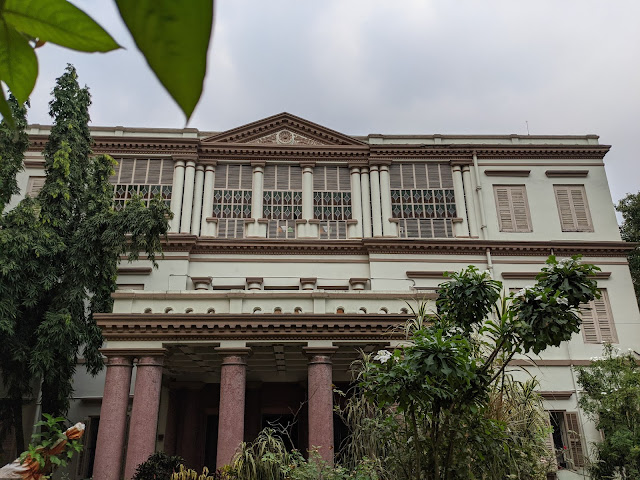This October I went home, after almost 2 years. It was a long wait. Sometimes it feels that I have lost the perception of time/date/day. Is it due to COVID or due to the February winter storm or simply due to age?? I don't know..
The journey took more than 36 hours with long transits, but I finally reached home and I am very thankful for that. Thankful for all the people I have in my life, thankful for all the conversations that I can have with my family and friends..thankful for all the memories we make together.
It was a short trip for about 12 days. The Autumn sun and some late splashes of Monsoon made my days. And in between the Durgapuja festivities, I made couple of trip to the embassy to renew visa for Maa. As we were ferrying from North to South Kolkata, one of the days, we decided to visit Raja Ram Mohan Roy's House.
I find it very fulfilling to visit the houses of the people whom I admire and respect. They are the people who are gone, but will be remembered for the centuries to come. For me it is a way to pay tribute, a moment to introspect and think about the life and work of the people who has shaped my life.
The residential house of Raja Ram Mohan Roy was converted to a museum during the early 2000's. Sadly, not many people are aware of this museum. So there is not much footfall. Maa and I spent a quiet Autumn in exploring the house of Raja Ram Mohan.
Raja Ram Mohan Roy is considered the pioneer of the modern Indian Renaissance for the remarkable reforms he brought in 18th and 19th century India. Among his efforts, the abolition of the Sati Daha Pratha was the most prominent. It is said that Raja witnessed her sister-in-law falling prey to "Sati". This tragedy affected Raja and he dedicated himself to eradicate the evil custom.
The title 'Raja' was given to him by the Mughal emperor Akbar. He is also called the modern man of India.
 |
| Entrance plaque to the house |
Tucked inside Simla, Machuabazar, the big palatial house evokes awe and emotion.
 |
Entrance to the Shimla House
The three-storied mansion was the place where Raja would hold his meetings for the Atmiya Sabha ( precursor to the Brahmo Samaj). This is the place that has witnessed Raja's struggle with social justice and brutality in India. One part of the mansion is kept intact, with the wooden staircases as present in the original building. The other part of the mansion has gone through modernization and has been converted to a building.
The museum contains relics, possession and writings of Raja. Many of his original writings in Farsi are displayed as a memorabilia. Arabi and Farsi were considered as official language those days. It also contains a replica of the death mask of Raja. Stained glass windows
We wandered around the several galleries of second floor. I was trying to think about the period of late 1700 to early 1800. Bengal fall down during the battle of Palashi (1757) and witnessed a devastating famine around 1770. This was the time when Mughal emperor Akbar was reigning at Delhi, the East India Company slowly and steadily gaining control over the Indian subcontinent. And at the South, the Maratha kings were still holding the fort. What was it like to live and work in those times? What was to recover from famine and slowly realizing the colonial rule? How was the social fabric - woven together or was it barely making together? Was there a concept of fair trade/fair pay?
Only our footsteps from the forlorn hall replied back to my thoughts. The huge hallways overlook the spacious gardens which looked vibrant green. One end of the garden hosts a ceremonial gate. Legend says that this gate used to be covered with brass and gold. The ceremonial gate is a recent construction, a replica of the old one. I honestly cannot comment on the authenticity of the design elements. Sometimes the colors/motifs looked too bright or contemporary to me.
There are also remnants of an old swing pole. I had read narratives of Ram Mohan Roy on the swing having conversation with the young Debendra Nath Tagore - often joking on his food habits and talking about life in general.
On the ground floor there is a library/meeting room which had a double swinging/batwing door. This almost resembles the doctor's office in old black and white Bengali movies!
Life flows by... some 200 years after, As a woman, I know I have been very fortunate to be a born in an era where re-marriages are possible, Sati has been abolished and many of these are possible due to the relentless commitment by Raja Ram Mohan Roy.
I am back to the other side of the ocean now .. life goes by. I read this poem recently :
You’d better slow down
Don’t dance so fast. Time is short.
The music won’t last. When you run so fast to get somewhere
You miss half the fun of getting there. When you worry and hurry through the day,
It is like an unopened gift thrown away. Life is not a race.
Do take it slower. Hear the music
Before the song is over. |





No comments:
Post a Comment